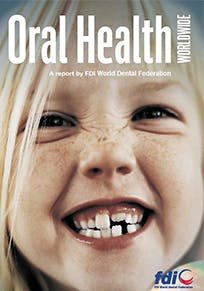Almost 100% of adults and 60% to 90% of schoolchildren worldwide suffer from dental caries.(1) Oral diseases are very common, but do not receive the consideration they deserve. This is especially true in third world countries, and those with poor health-care systems. The World Dental Federation (FDI) presented the most recent information on oral health on a very noteworthy date, World Oral Health Day.(2)
The report highlights the key impediments to achieving universal oral health, considered by most a human right.(3) It also suggests that oral health is an essential portion of general health and vital to the overall welfare of all people. It was presented at the British Dental Association (BDA) in London by Dr. Jean-Luc Eiselé, executive director of FDI and by David Williams, professor of Global Oral Health, Bart's and the London School of Medicine and Dentistry. There is a fact sheet on “Dental Diseases and Oral Health.”(4) The report outlines how oral cancer is among the ten most common cancers in the world, especially in low-income and under developed countries. In Southeast Asia, men have a higher incidence of oral cancer and mortality rates than women. The risk of oral cancer is fifteen times higher when one uses both tobacco alcohol, and these two risk factors account for approximately 90% of oral cancers in this part of the world.(1) Also, the report shows that periodontal diseases are the leading cause of tooth loss around the globe. Noma is widespread in developing countries, with many people left untreated. Noma is a rapidly progressive, polymicrobial, opportunistic infection that occurs during periods of compromised immune function.(5) It is a devastating gangrenous infection affecting the face. The victims of Noma are mainly children under the age of 6, caught in a vicious circle of extreme poverty and chronic malnutrition.(5)
The sad news is that, if left untreated, it is fatal in 80% of cases. The good news, early treatment can save lives. According to the report, the majority of oral diseases are related to socio-economic factors. Only 60% of the world’s population access to oral care.(1) We also know that oral health can be affected by chronic and infectious diseases, many of which show symptoms in the mouth. Where do we go from here? Read the report, and the five steps for optimal oral health outlined by the FDI World Dental Federation. Take part in the 2015 World Oral Health Day!RELATED | Caries vaccine: a viable option?
References 1. Press release. http://www.worldoralhealthday.com/oral-health-worldwide/. 2. http://www.fdiworldental.org/events/world-oral-health-day/2014.aspx. 3. http://www.worldoralhealthday.com/wp-content/uploads/2014/03/FDIWhitePaper_OralHealthWorldwide.pdf. 4. http://www.who.int/oral_health/publications/en/orh_fact_sheet.pdf. 5. http://www.facingafrica.org/.More by Maria Perno Goldie:Triclosan: the good, the bad, and the uglyUpdate on infection diseases
References 1. Press release. http://www.worldoralhealthday.com/oral-health-worldwide/. 2. http://www.fdiworldental.org/events/world-oral-health-day/2014.aspx. 3. http://www.worldoralhealthday.com/wp-content/uploads/2014/03/FDIWhitePaper_OralHealthWorldwide.pdf. 4. http://www.who.int/oral_health/publications/en/orh_fact_sheet.pdf. 5. http://www.facingafrica.org/.More by Maria Perno Goldie:Triclosan: the good, the bad, and the uglyUpdate on infection diseases
Maria Perno Goldie, RDH, MS, is the editorial director of RDH eVillage FOCUS.









